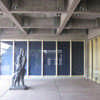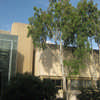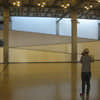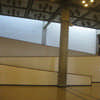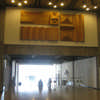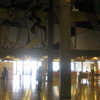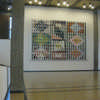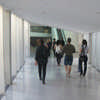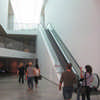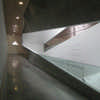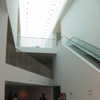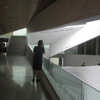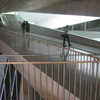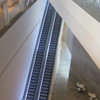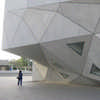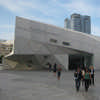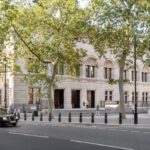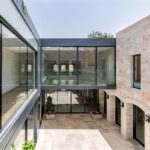Tel Aviv Museum of Modern and Contemporary Art architect, New Israel architecture design
Tel Aviv Museum of Art : Herta and Paul Amir Building
Contemporary Building in Israel design by Preston Scott Cohen.
New photos, taken last week:
The original building:
16 May 2013
Tel Aviv Museum of Art Building
Herta and Paul Amir Building
Design: Preston Scott Cohen, Inc.
27 Oct 2011
Tel Aviv Museum of Art
Herta and Paul Amir Building Design, Israel
Design: Preston Scott Cohen, Inc.
Tel Aviv, 64239, Israel
+972 3-607-7020
The Tel Aviv Museum Of Art Celebrates November 2 Opening Of Its New International Landmark, The Herta And Paul Amir Building
New Building Designed By Preston Scott Cohen Is A Striking Contribution To Tel Aviv’s Architecture And A Major Addition To Israel’s Principal Museum Of Modern And Contemporary Art
Site-specific Exhibition By Anselm Kiefer Inaugurates Special Exhibition Galleries;
Permanent Collection Galleries Include Installation Of The Museum’s Comprehensive Collection Of Israeli Art
TEL AVIV, ISRAEL, October 27, 2011 – An international city renowned for its vibrant young culture and tradition of modern architecture, and a museum known as the very heart of its nation’s thriving arts community, today opened the doors of a visionary new building that may alter the future of museum architecture and lift its country to new prominence in the world of contemporary art.
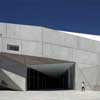
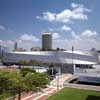

pictures © Amit Geron Courtesy Tel Aviv Museum of Art
The Tel Aviv Museum of Art began a week of festivities—including a concert, an architecture symposium and a gala ceremony in the presence of Israeli President Shimon Peres—leading up to the November 2 public opening of its new Herta and Paul Amir Building. Designed by Preston Scott Cohen, the 195,000-square-foot building adds an unprecedented work of contemporary architecture to the campus of the Museum—Israel’s principal institution of modern and contemporary art—and provides a new international landmark at the center of Israel’s cultural capital.
Ron Huldai, Mayor of the Municipality of Tel Aviv, stated, “We celebrate the opening of the Herta and Paul Amir Building as a confirmation that Tel Aviv is today a global city and will remain one far into the future. Over the past decade, we have invested $250 million in our cultural and historical institutions in support of Tel Aviv’s leading international role. Today, with representatives of the art world gathered here for the inauguration, the Herta and Paul Amir Building stands as the symbol of all we have accomplished and all we aspire to achieve.”
Permanent Collection Galleries
The Tel Aviv Museum of Art holds a comprehensive collection of Israeli art, representing all major trends and artists. A selection of some 250 of these works, dating from 1906 to the present, will be on view at the time of the inauguration of the Amir Building, presented in 18,500 square feet of galleries, in the country’s largest permanent installation of Israeli art.
Also on view in the permanent collection galleries of the Amir Building during the opening period will be an installation of the Museum’s important holdings of Israeli photography of the past twenty years; Utopias of Expressionism and Cure by Expression, a pair of exhibitions selected from the collection of prints and drawings, focusing on the Museum’s notable holdings in German Expressionism; two exhibitions of Israeli design, Library by Chanan DeLange and Circle by Yaakov Kaufman; and the exhibition Five Moments: Trajectories in the Architecture of the Tel Aviv Museum of Art, organized by guest curators Jascha Grobman and Ariel Blonder, exploring the historical context of the design of the major structures of the Museum from the original Dizengoff House (1932) to the Amir Building.
“We are proud that the physical and spiritual heart of this wonderful new building is dedicated to the heritage of Israeli art, presented in all its richness and variety,” stated Shuli Kislev, Deputy Director of the Museum. “We also feel deeply moved by the knowledge that these installations are in effect a tribute to the memory of our late Director and Chief Curator, Professor Mordechai Omer, who did so much to build the collection and to serve Israel’s artistic community.”

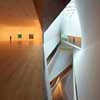
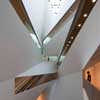
pictures © Amit Geron Courtesy Tel Aviv Museum of Art
Shevirat Ha-Kelim: The Breaking of the Vessels
To inaugurate its new 9,000-square-foot temporary exhibitions gallery in the Amir Building, the Museum will present a site-specific exhibition of new and recent works by Anselm Kiefer, Shevirat Ha-Kelim: The Breaking of the Vessels, organized by Mordechai Omer in close collaboration with the artist. Drawn predominantly from the artist’s own collection, the exhibition presents an extraordinary selection of Kiefer’s monumental paintings, sculptures, woodcuts and installations on themes of Jewish history and mysticism. The exhibition features five new sculptures from the artist’s Women of Antiquity series; five new monumental, mixed-media paintings; three more recent paintings from Kiefer’s own collection, and another two from private collections; three large new woodcuts, each measuring approximately 2 x 3 meters (6.5 x 9.8 feet); a version of the large-scale installation East-West Diwan; and a new installation, Shevirat Ha-Kelim: The Breaking of the Vessels, created by the artist on site.
Among the subjects addressed in the works in Shevirat Ha-Kelim: The Breaking of the Vessels are the stories of Biblical figures such as Cain and Abel, Noah and Samson; the Kabbalistic ideas of the “tree of Sephirot” (or emanations of God) and the shattering of a formerly unified world (shevirat ha-kelim, or the breaking of the vessels); Isaac Abravanel, the 15th-century Biblical scholar and statesman who was forced from Spain in the expulsion of 1492; and Paul Celan, the Romanian-born, German-language Jewish poet who survived the Holocaust and was one of the first in the post-war era to write about these experiences.
The Design of the Herta and Paul Amir Building
The freestanding concrete-and-glass Herta and Paul Amir Building establishes a dialogue with the existing structures of the Tel Aviv Museum of Art and with the renowned modern architecture of Tel Aviv, with its traditions of Mendelsohn, the Bauhaus and the White City. On the inside, the Amir Building reveals that it is built around a spiraling, top-lit, 87-foot-high atrium known as the Lightfall, whose subtly twisting surfaces curve and veer up and down through the structure. There are five levels to the building—two above grade and three below—which twist from floor to floor to accommodate large, rectangular galleries within the compact, irregular site. The stairs and ramped promenades of the Lightfall serve as the surprising, continually unfolding vertical circulation through these floors, connecting the disparate angles of the galleries and allowing natural light to refract into the deepest recesses of the half-buried building.
“I am incredibly proud to have had the opportunity to work with the Tel Aviv Museum of Art on the Amir Building,” Preston Scott Cohen stated. “The Museum’s program set the challenge of providing several floors of large, neutral, rectangular galleries within a tight, idiosyncratic, triangular site. The solution we proposed was to ‘square the triangle’ by constructing the levels on different axes, which deviate significantly from floor to floor and are unified by the Lightfall. This decision enabled us to combine two seemingly irreconcilable paradigms of the contemporary art museum: the museum of neutral white boxes, which provides optimal, flexible space for the exhibition of art, and the museum of spectacle, which moves visitors and offers a remarkable social experience. In this way, the Amir Building’s synthesis of radical and conventional geometries produces a new type of museum experience, one that is as rooted in the Baroque as it is in the Modern.”
The Amir Building doubles the exhibition space of the Tel Aviv Museum of Art, giving it 40,900 square feet of new galleries, as well as 10,000 square feet for its library. Among other facilities, the Amir Building also provides a new 7,000-square-foot auditorium, allowing the institution to expand the busy schedule of film screenings, music performances, readings, lectures and discussion programs that make the Tel Aviv Museum of Art an indispensable center of activity for the city’s artistic and cultural community.
Paul Amir, the Los Angeles-based real-estate developer and philanthropist who with his wife Herta provided the naming gift for the Museum’s new building, stated, “We feel privileged to have been able to advance the work of the Tel Aviv Museum of Art, an institution that is truly at the heart of Israel’s creative community. With this exceptional building by Preston Scott Cohen, and with the ability to showcase the work of Israel’s artists as never before, the Museum now has the potential to step up to a prominent new role on the international scene, to the benefit of everyone.”
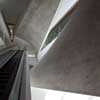
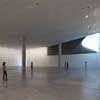
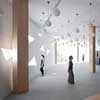
pictures © Amit Geron Courtesy Tel Aviv Museum of Art
Opening Symposium on Architecture and Museums
On November 1, 2011, the auditorium will be the venue for a day-long symposium entitled Architecture and Museums at the Beginning of the 21st Century. Preston Scott Cohen, Sylvia Lavin, Jeff Kipnis, Jesse Reiser, Nanako Umemoto, Greg Lynn, Inaki Abalos and Ben Van Berkel will discuss the tension between the two prevailing models of museums today: the museum of neutral white boxes, allowing for maximum curatorial freedom, and the museum of architectural identity, conducive to the production of public spectacle. These defining issues of curatorial vs. architectural conceptions, and of art vs. public life, motivated the design of the new Herta and Paul Amir Building, where the galleries are the life and soul of the Museum, even while being organized around the powerful architectural spectacle of the spiraling Lightfall. Among other issues, the symposium will consider to what degree the new building of the Tel Aviv Museum of Art might represent a new direction in international museum architecture: an interiorized and socialized space of spectacle, as opposed to the 1990s model of an exterior sculptural object displayed to the city.
About the Tel Aviv Museum of Art
The campus of the Tel Aviv Museum of Art is located in the heart of Tel Aviv, immediately adjacent to the Golda Meir Cultural & Art Center (with the New Israeli Opera and the Cameri Theater) and the Beit Ariela Municipal Library. The previous existing main building, a 175,000-square-foot structure by Dan Eytan and Yitzchak Yashar, opened in 1971 and was expanded with an 11,300-square-foot Sculpture Garden (opened 1996) and the 32,300-square-foot Gabrielle Rich Wing (Dan Eytan, 1999). When the Amir Building opens in November 2011, galleries in the main building that were previously used for Israeli art, photography, video, and design and architecture will be dedicated to the Museum’s extensive program of changing exhibitions. The central Sam and Ayala Zacks Gallery in the main building, previously used for changing exhibitions, will now be dedicated to an installation from the permanent collection of European and American art from the era after World War II.
About Preston Scott Cohen Inc.
Preston Scott Cohen is the founder and principal of Preston Scott Cohen, Inc., a full-service architecture firm based in Cambridge, Massachusetts. Commissions encompass projects of diverse scales and types including houses, educational facilities, cultural institutions and urban designs for private owners, institutions, government agencies and corporations. Notable projects include the Taiyuan Museum of Art in Taiyuan, China; Datong Library, Datong, China; Ordos 20+10 Office Building, Ordos, China; Nanjing Performing Arts Center, Nanjing, China; Goodman House, Pine Plains, NY; Inman House, Cambridge, MA; and Torus House, Old Chatham, NY.
Cohen was named Chair of the Department of Architecture at the Harvard University Graduate School of Design in 2008 and serves there as the Gerald M. McCue Professor of Architecture. He is the author of Contested Symmetries (Princeton Architectural Press, 2001) and numerous theoretical and historical essays on architecture. His work has been widely published and exhibited and is in numerous collections, including The Museum of Modern Art, New York, The Cooper-Hewitt National Design Museum, San Francisco Museum of Modern Art, Museum of Contemporary Art, Los Angeles and the Fogg Museum of Art, Harvard. He lectures regularly in prestigious venues around the world.
Cohen’s work has been the subject of numerous theoretical assessments by renowned critics and historians including Sylvia Lavin, Antoine Picon, Michael Hays, Nikolaus Kuhnert, Terry Riley, Robert Somol, Hashim Sarkis and Rafael Moneo. He was the Frank Gehry International Chair at the University of Toronto (2004) and the Perloff Professor at UCLA (2002). He has held faculty positions at Princeton, RISD, and Ohio State University.
Tel Aviv Museum of Art : Herta and Paul Amir Building images / information received 271011
13 + 14 Apr 2011
Tel Aviv Museum of Modern and Contemporary Art
Israel
Design: Preston Scott Cohen, Inc.
TEL AVIV MUSEUM OF ART TO OPEN ITS NEW HERTA AND PAUL AMIR BUILDING, DESIGNED BY PRESTON SCOTT COHEN, ON 2 NOVEMBER 2011
Israel’s Leading Museum of Modern and Contemporary Art Adds a New Landmark to the Cultural Capital, Provides Galleries for Its Comprehensive Collection of Israeli Art
Inaugural Offerings Will Include a Major Site-Specific Temporary Exhibition by Anselm Kiefer
TEL AVIV, 13 April 2011 — The Tel Aviv Museum of Art announced today that it will celebrate the public opening of its £33.7 million Herta and Paul Amir Building on 2 November 2011. The 195,000-square-foot building adds a visionary work of contemporary architecture to the Museum’s campus in the heart of Tel Aviv and provides a new international landmark for Israel’s cultural capital.
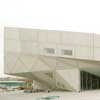
picture : Ohad Matalon Courtesy Tel Aviv Museum of Art
Designed by Preston Scott Cohen, Inc., of Cambridge, Massachusetts, the freestanding concrete-and-glass building is a tour de force of complex geometry and light-filled space. Outside, the gleaming and angular Amir Building establishes a dialogue with the Museum’s existing structures and the renowned modern architecture of Tel Aviv, with its traditions of Mendelsohn, the Bauhaus and the White City. On the inside, the Amir Building reveals that it is built around a spiraling, top-lit, 87-foot-high atrium known as the Lightfall, whose subtly twisting surfaces curve and veer up and down through the structure. There are five levels to the building—two above grade and three below—which twist from floor to floor, to accommodate large, rectangular galleries within the compact, irregular site. The stairs and ramped promenades of the Lightfall serve as the surprising, continually unfolding vertical circulation through these floors, connecting the disparate angles of the galleries and allowing natural light to refract into the deepest recesses of the half-buried building.
“We are immensely pleased to be able to add much-needed space to our facilities while making an exciting and important contribution to the landscape of our city,” stated Professor Mordechai Omer, Director and Chief Curator of the Tel Aviv Museum of Art. “I believe the Israeli public and visitors from around the world will share our excitement. As if in a single gesture, Preston Scott Cohen’s building is startling and original and yet beautifully practical as a setting for our works of art.”
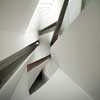
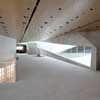
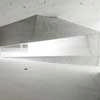
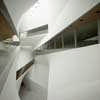
pictures : Ohad Matalon Courtesy Tel Aviv Museum of Art
The Amir Building houses 18,500 square feet of gallery space for the Museum’s comprehensive collection of Israeli art. A selection of some 250 of these works will be on view in the inaugural installation, dating from 1906 to the present. Also on view in the permanent collection galleries of the Amir Building during the opening period will be:
– an installation of Israeli photography of the past twenty years;
– a series of two consecutive exhibitions, Utopias of Expressionism and Cure by Expression, showing the strength of the collection of prints and drawings;
– two installations of work by leading Israeli designers, Library by Chanan DeLange and Circle by Yaakov Kaufman;
– and an exhibition documenting the design of the five buildings of the Tel Aviv Museum of Art, from the original Dizengoff House to the Amir Building, organized by guest curators Jascha Grobman and Ariel Blonder.
To inaugurate its new 9,000-square-foot temporary exhibitions gallery in the Amir Building, the Museum will present Kiefer in Tel Aviv, a site-specific exhibition organised by Mordechai Omer in collaboration with the artist. Large-scale works by Kiefer inspired by themes of the Hebrew Bible, Jewish myths and mysticism and German-Jewish history will surround two of the artist’s monumental enclosures: East-West, housing 44 huge metal plates imprinted with images of paintings and objects, and a specially conceived version of The Library, whose multiple pewter and lead “books” are a record of diagrams and photographs.
Among its other facilities, the Amir Building provides a new 7,000-square-foot auditorium, allowing the institution to expand the busy schedule of film screenings, music performances, readings, lectures and discussion programs that make the Tel Aviv Museum of Art an indispensable center of activity for the city’s artistic and cultural community. On November 1, 2011, the auditorium will be the venue for a symposium on the architecture of contemporary museums, featuring Preston Scott Cohen in conversation with Eran Neuman and a roster of international architects.
Speaking about his design for the Amir Building, Preston Scott Cohen stated, “The Museum’s program set the challenge of providing several floors of large, neutral, rectangular galleries within a tight, idiosyncratic, triangular site. The solution we proposed was to ‘square the triangle’ by constructing the levels on different axes, which deviate significantly from floor to floor and are unified by the Lightfall. This decision enabled us to combine two seemingly irreconcilable paradigms of the contemporary art museum: the museum of neutral white boxes, which provides optimal, flexible space for the exhibition of art, and the museum of spectacle, which moves visitors and offers a remarkable social experience. In this way, the Amir Building’s synthesis of radical and conventional geometries produces a new type of museum experience, one that is as rooted in the Baroque as it is in the Modern.”
Ron Huldai, Mayor of the Municipality of Tel Aviv, commented, “We see the opening of the Amir Building as a landmark moment to inaugurate our Tel Aviv Global City initiative, a strategic plan that follows an investment of $250 million in our cultural and historical institutions over the past decade. To make Tel Aviv Global City a part of everyone’s life from the very beginning, we will launch The Year of Art in September 2011. The city will present a calendar of dozens of exhibitions, conferences, community projects, educational initiatives and festivals, many of them with international partners—and as the centerpiece, we will celebrate the opening of the Herta and Paul Amir Building.”
The architectural competition for the Herta and Paul Amir Building was conducted in the first half of 2003. Design development began in 2005, and the groundbreaking was held in 2007.
The Museum campus is located in the heart of Tel Aviv, immediately adjacent to the Golda Meir Cultural & Art Center (with the New Israeli Opera and the Cameri Theater) and the Beit Ariela Municipal Library. The existing main building, a 175,000-square-foot structure by Dan Eytan and Yitzchak Yashar, opened in 1971 and was expanded with an 11,300-square-foot Sculpture Garden (opened 1996) and the 32,300-square-foot Gabrielle Rich Wing (Dan Eytan, 1999). When the Amir Building opens in November 2011, galleries in the main building that were previously used for Israeli art, photography, video, and design and architecture will be dedicated to the Museum’s extensive program of changing exhibitions. The central Sam and Ayala Zacks Gallery in the main building, previously used for changing exhibitions, will now be dedicated to an installation from the permanent collection of European and American art from the era after World War II.
Tel Aviv Museum of Art : Herta and Paul Amir Building information received 130411
Address: 27 Shaul Hamelech Blvd, POB 33288, The Golda Meir Cultural and Art Center, 61332 Tel Aviv, Israel
Contact Tel Aviv Museum of Art: +972 3-607-7020
Preston Scott Cohen Architects
Location: 27 Shaul Hamelech Blvd, 61332 Tel Aviv, Israel
Israel Architecture
Contemporary Architecture in Israel
Israeli Architecture Designs – chronological list
Jerusalem Architecture Walking Tours
Tel Aviv Architecture Walking Tours
Tel Aviv Building
Contemporary Israel Museum Buildings Selection
Tel Aviv Museum of Art Extension
Design: Preston Scott Cohen
Tel Aviv Museum of Art
Museum + Archive – Jabotinsky Center, Ramat-Gan
Design: Chyutin Architects
Museum + Archive – Jabotinsky Center
Umm el-Fahem Museum for Contemporary Art Israel
Design: SO architecture
Um el Fahem Museum
Design Museum Holon, Tel Aviv – review + photos by e-architect editor Adrian Welch
Design: Ron Arad
Design Museum Holon
The Norman Hotel, Nahmani Street 23-25, Tel Aviv-Yafo
Design: architect Moshe Cerner ; refurbishment by Yoav Messer Architects Ltd.
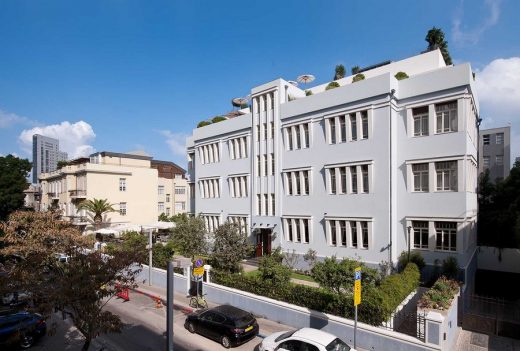
photo from architect
The Norman Hotel in Tel Aviv
Comments / photos for the Tel Aviv Museum of Art – Herta and Paul Amir Building Israel page welcome

